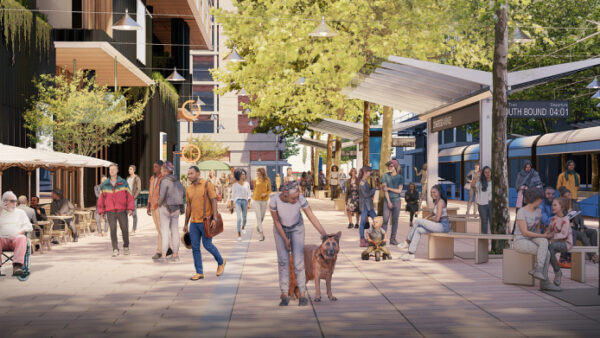France is to make its first attempt at timber tower construction with two tall wooden buildings in Bordeaux.
The towers, reaching 50m and 57m in height, will be developed in the centre of the city by Bordeaux Euratlantique, a public body involved in modernising Bordeaux.
The project team for “Hypérion”, the 18-storey (57m) residential tower, will include Eiffage, specialist wood contractor Woodeum, social landlord Clairsienne and architect Jean-Paul Viguier & Associés. When complete, it will contain 82 apartments.
Wood of this type is as good at resisting fire as concrete. The CLT we use is very solid: the first flame does not appear until 400°C– Guillaume Poitrinal, the president of Woodeum
The 50m office tower is to be built by a team led by French developer Kaufman & Broad to a design by local architect Art & Build. This building, which has been dubbed “Silva”, will be 80% made from locally sourced cross-laminated timber (CLT) with glulam plywood bracing.Â
Scheduled for completion in 2020, the towers will be part of the new Belvedere quarter adjacent to the city’s Saint-Jean station.
Both designs were chosen in an open competition held by Bordeaux Euratlantique, judged by a jury chaired by city mayor and former prime minister of France, Alain Juppé.
Work on Hypérion is expected to begin on site in September 2017.
The timber tower scheme won plaudits from environmentalists.
“This is a major contribution to the development of this technology,” said Canddie Magdelenat, who heads the Sustainable Cities Programme at the WWF, to Le Monde.
“On more traditional sites, the construction phase is very energy-intensive and really needs to be improved. CLT has the additional merit of using very little glue, and therefore to limit emissions of pollutants such as volatile organic compounds.”

Silva: the wooden office designed by Art & Build (Rendering courtesy of the architect)
She added that CLT technology was still underdeveloped in France, particularly in comparison with Canada’s recent achievements with the material.
Another large wooden building has already been earmarked for the Ris-Orangis commune in the southern outskirts of Paris. This will be a 150m long, four-storey structure designed by Wilmotte & Associés that is due to be completed in September next year.
The building material in this case will be Austrian pine, but the wood will be imported as logs and processed into CLT locally.
Guillaume Poitrinal, the president of Woodeum, defended the material against charges that it presented more of a fire hazard than concrete frame structures.
“Wood of this type is as good at resisting fire as concrete,” he said. “Concrete doesn’t burn, but it may collapse at high temperatures, and although wood is combustible, the more massive it is, the more slowly it burns. The CLT we use is very solid: the first flame does not appear until 400°C.”
Renderings courtesy of the architects
Comments
Comments are closed.











Firstly, surprised to hear France has not cross-pollinated with Canada on such materials before embarking on such a project. Main problem as usual, with be the very dangerous construction phase for such buildings, where many severe fires in a range of ‘green-build’ technologies have occurred.
If they survive this phase, does French building codes require sprinklers in such premises?
If not the occupants will have the opportunity to test out the fire safety for themselves. I realise they could not possibly look at any lessons learned in the US where all ‘green-build’ HMOs are sprinklered, but surely their Canadian cousins could be trusted??
Hello Mike,
Not sure what yur information sources are, but there has indeed been a lot of cross-pollination, not necessarily with Canada (although Michael Green must be thanked for his open-source research) but with major European manufacturers of CLT and other industrialised products. We have been using CLT in France for over 10 years in public buildings so are quite accustomed to the challenges of building code compliancy in timber buildings. Additionally, our practice has a 34m CLT building under construction and we are developing viable and tested solutions to tall timber construction as we build. Europeans rarely use sprinkler systems and the fire regulations take an altogether different approach in most cases.
Again pushing the limits in the construction limits
The fire is less damage than the water change. For structural it is right for redundant and easily replaceable.